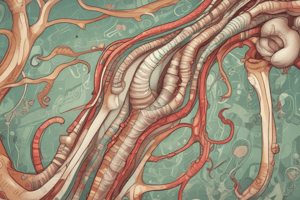Podcast
Questions and Answers
What is the primary function of the epiploic appendages in the large intestine?
What is the primary function of the epiploic appendages in the large intestine?
- To store fat for energy (correct)
- To produce digestive enzymes
- To support the structure of the intestinal wall
- To absorb water from the fecal matter
Which section of the large intestine is responsible for the initial processing of fecal matter?
Which section of the large intestine is responsible for the initial processing of fecal matter?
- Sigmoid colon
- Rectum (correct)
- Cecum
- Appendix
What is the main function of lymphoid tissue in the appendix?
What is the main function of lymphoid tissue in the appendix?
- Defense against pathogens (correct)
- Storage of fat for energy
- Support of intestinal structure
- Production of digestive enzymes
Which section of the colon is located between the ascending colon and the sigmoid colon?
Which section of the colon is located between the ascending colon and the sigmoid colon?
What is the significance of the tenia coli in the large intestine?
What is the significance of the tenia coli in the large intestine?
Which organ is responsible for producing bile to aid in fat digestion?
Which organ is responsible for producing bile to aid in fat digestion?
What main actions are involved in the process of digestion?
What main actions are involved in the process of digestion?
Which layer in the GI tract performs segmentation and peristalsis?
Which layer in the GI tract performs segmentation and peristalsis?
Which organ plays a crucial role in digestion by producing saliva with enzymes?
Which organ plays a crucial role in digestion by producing saliva with enzymes?
What is the main function of the large intestine in the digestive system?
What is the main function of the large intestine in the digestive system?
What is the role of the stomach in the digestion process?
What is the role of the stomach in the digestion process?
Study Notes
- The digestive system consists of the alimentary canal (GI tract) and accessory digestive organs like teeth, tongue, gallbladder, salivary glands, liver, and pancreas.
- The process of digestion involves six main actions: ingestion, propulsion, mechanical breakdown, digestion (enzymatic breakdown), absorption, and defecation.
- The GI tract is structured with layers including mucosa (secretes enzymes, absorbs nutrients), submucosa (contains blood vessels and nerve fibers), muscularis externa (performs segmentation and peristalsis), and serosa (connective tissue covering).
- Intrinsic nerve plexuses in the GI tract regulate digestive system activity.
- Accessory organs like the mouth (oral cavity), salivary glands (produce saliva with enzymes), and teeth (aid in mastication) play crucial roles in digestion.
- The stomach produces gastric juice in an acidic environment to break down proteins with the help of pepsin, while the small intestine is responsible for completing digestion and absorbing nutrients.
- The liver produces bile to aid in fat digestion, the gallbladder stores bile, and the pancreas produces pancreatic juice containing enzymes for food breakdown.
- The large intestine absorbs water and nutrients, while the small intestine is responsible for most absorption and digestion processes.- The large intestine is responsible for absorbing water from food residues and compacting them into fecal matter.
- The large intestine is made up of three bands of smooth muscle called the tenia coli, sacs called haustra, and fat-filled pouches called epiploic appendages.
- The large intestine is divided into different sections including the cecum, appendix, colon, rectum, and anal canal.
- The cecum is the first section of the large intestine and is followed by the appendix, which contains lymphoid tissue.
- The colon is further divided into the ascending colon, transverse colon, descending colon, and sigmoid colon.
- The rectum and anal canal are the final parts of the large intestine where the fecal matter is eliminated from the body.
- Each biomolecule, such as proteins, carbohydrates, and fats, requires specific enzymes for digestion. These pathways are important to understand in detail.
- More information on the mechanism of digestion and specific biomolecule breakdown will be covered in a future nutrition series.
Studying That Suits You
Use AI to generate personalized quizzes and flashcards to suit your learning preferences.
Description
Explore the structure and function of the digestive system, from the alimentary canal to the accessory digestive organs, and learn about the process of digestion involving ingestion, propulsion, absorption, and more. Understand the roles of organs like the liver, pancreas, and large intestine in digestion.




